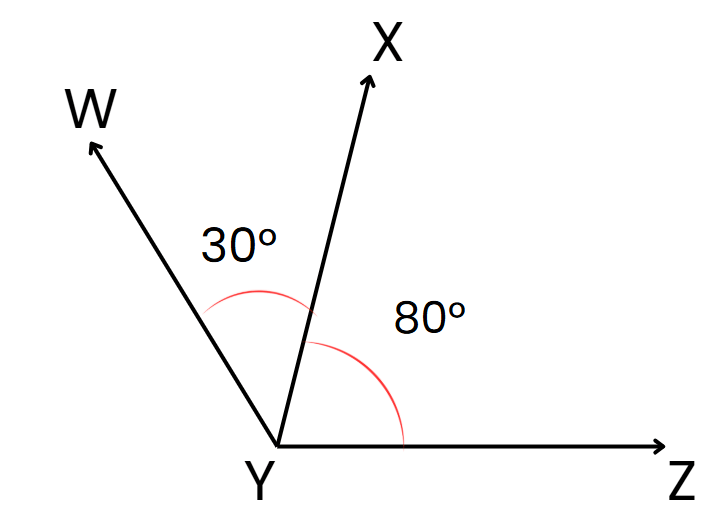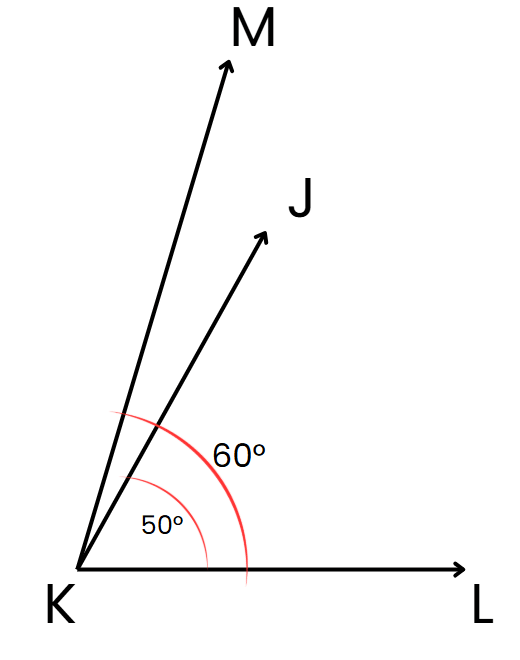Practice Questions: Lines and Angles | Maths Olympiad Class 6 PDF Download
Q1: How many right angles form a straight angle?
Sol:
We know that a right angle measures 90°.
A straight angle measures 180°.
To find how many right angles make one straight angle:
So, two right angles form a straight angle.
Answer: Two right angles.
Q2: If ∠XYZ=80° and ∠XYW=30°, and both angles share the same arm  , what is the angle between the non-shared arms?
, what is the angle between the non-shared arms?
Sol:
The total angle between the non-shared arms is the sum of both given angles:
80° + 30° = 110°
So, the angle between the non-shared arms is 110°.
Answer: 110°
Q3: Two angles ∠JKL=50° and ∠MKL=60° share a common vertex K. What is their combined angle?
Sol:
When two angles share a common vertex and arm, we can add them to get the combined angle:
50° + 60° = 110°
So, the total angle formed is 110°.
Answer: 110°
Q4: A student measures an angle of 100° using a protractor, but the reading shows 95°. What is the misalignment angle?
Sol:
To find the misalignment, subtract the incorrect reading from the actual angle:
100° − 95° = 5°
So, the protractor was misaligned by 5°.
Answer: 5° misalignment
Q5: A 160° angle is bisected three times. What is the measure of the smallest angle formed after all the bisections?
Sol:
We divide the angle step by step:
First bisection:
160° ÷ 2 = 80°Second bisection:
80° ÷ 2 = 40°Third bisection:
40° ÷ 2 = 20°
After three bisections, the smallest angle formed is 20°.
Answer: 20°
Q6: A point is marked on a paper and labeled P. How many dimensions does it have?
Sol: A point only shows a position and has no length, width, or height.
Answer: A point has zero dimensions.
Q7: Is an angle measuring 170° acute, right, or obtuse?
Sol: An angle between 90° and 180° is called an obtuse angle.
Answer: Obtuse angle.
Q8: Two angles share a common vertex Q and one common arm. One measures 60°, the other 45°. What is the angle between the outer arms?
Sol: The angle between the outer arms is the sum of the angles:
60° + 45° = 105°
Answer: 105°
Q9: Compare ∠ABC=70° and ∠DEF=110°. Which is larger?
Sol: 110° > 70°, so ∠DEF is larger.
Answer: ∠DEF is larger.
Q10: A carpenter uses a square tool that forms a 90° angle. What is this angle called?
Sol: An angle of 90° is called a right angle.
Answer: Right angle.
Q11: Classify the angle made by the hands of a clock at 10 o’clock.
Sol:
- At 10 o’clock, the hour hand is at 10 and the minute hand is at 12.
- The angle between each number on the clock = 360° ÷ 12 = 30°.
- From 10 to 12, there are 2 hour spaces.
- So, the angle between the hands = 2 × 30° = 60°
Answer: The angle is 60°, which is an acute angle (since it's less than 90°).
Q12: The sum of three angles on a straight line is 180°. Two angles are 2x and x. Find the third if it's double the second.
Sol:
Let angles be 2x, x, and 2x.
Sum = 2x + x + 2x = 5x = 180°
⇒ x = 36°
Angles: 72°, 36°, 72°
Answer: 72°, 36°, 72°
Q13: A paper circle is folded into a semicircle, then into a quarter circle, and once more. What is the angle at the final fold, and how many times was the original angle divided?
Sol:
Total angle of a full circle = 360°
Step 1:
First fold → semicircle
360° ÷ 2 = 180°
Step 2:
Second fold → quarter circle
180° ÷ 2 = 90°
Step 3:
Third fold
90° ÷ 2 = 45°
So, the final angle after 3 folds = 45°
Now, total number of equal parts the original circle is divided into:
360° ÷ 45° = 8 parts
Q14: A slit with a 72° angle is cut in cardboard. Three rotating arms have angles 70°, 72°, and 74°. Which arm(s) pass through the slit, and why?
Sol:
The slit angle is 72°.
For an arm to pass through, its angle must be equal to or smaller than the slit (but not wider).
The arm with 70° is narrower than the slit → it might pass through.
The arm with 72° is exactly equal → it fits perfectly.
The arm with 74° is wider than the slit → it will not pass.
However, usually only an arm exactly equal to the slit angle fits snugly without wobble or force.
Answer: Only the 72° arm passes through the slit, because it exactly matches the slit angle. The 70° is too narrow and the 74° is too wide.
Q15: A full turn is divided into five equal angles. What is the measure of each, and classify them.
Sol:
A full turn = 360°
Dividing into 5 equal angles:
360∘÷5=72∘
Since 72° < 90°, each angle is an acute angle.
Answer:
Each angle = 72°, and it is an acute angle.
|
30 videos|120 docs|59 tests
|
FAQs on Practice Questions: Lines and Angles - Maths Olympiad Class 6
| 1. What are the different types of angles that we learn in Class 6? |  |
| 2. How can we identify complementary and supplementary angles? |  |
| 3. What is the relationship between parallel lines and angles? |  |
| 4. How do we measure angles accurately? |  |
| 5. Why is it important to learn about lines and angles in Class 6? |  |






















